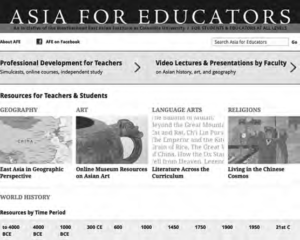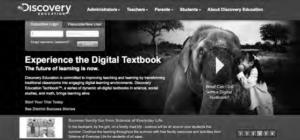Through the Internet, students in the United States and other countries have unprecedented opportunities to learn about Asia. Various factors influence a teacher’s ability to provide connections and relevant activities to engage students in topics relating to Asia. The age of modern media provides an accessible vehicle for all students to travel to the opposite side of the globe. Classroom instruction is readily supplemented with web resources that address current topics and explore historical content of countries in Asia.
Examples of Asia Online Resources
Followed by Sample Lesson Plan Descriptions
Asia for Educators: http://afe.easia.columbia.edu

This site provides links, lesson plans, and helpful resources for all class levels and areas. The museum database (OMuRAA) connected to this site gives links to visual collections of art in the various religious belief systems across Asia. Students can use this database to select and print out images in order to create a visual timeline of the religious arts in Asia. Afterward, they can place these images on the map regions to promote class discussion on the growth and confluence of religious ideas through the lens of the visual arts. See http://tiny.cc/zefzyw.
Lessons Plans by NCTA-Ohio State University
This site offers an extensive collection of lesson plans organized by region and created by NCTA-OSU participants. Using the premise of The Amazing RaceTV show, this activity focuses on Korea and is quickly adaptable for collaboration between two classrooms. Students create stations with learning tasks and compete to finish first.
Asia Society
Lesson plans are divided by grade level, with curriculum connections and intensive details. In a lesson plan on Japanese-American relationships during World War II, students can role-play and discuss the experience of Japanese internment during the years of the war. This lesson offers multiple parts, which can be used together or individually.
Discovery Education:

This subscription-based, high-quality video library supports teaching on a wide array of topics relating to Asia, and it is possible to select videos based on length and popularity among users. In the fifteen-minute video “Worldwide English: India,” students learn the perspective of Rahul, a young rock musician and computer programming student in Mumbai, as he leads viewers through a tour of history, changes, and traditions across India. (Membership is required to access link.)
Carolina Navigators Student Presentations:

Invite a virtual guest speaker like University of North Carolina student Zishu Chen, who in her nine to ten minute video relates the realities of a small town in China and encourages viewers to compare it to their own local context. Students can discuss the expectations and realities of urban and rural life with regards to what they have learned about the ancient water town of Wuzhen, China. See http://vimeo.com/40881548.
Multimedia Tools and Sample Classroom Uses
In the digital age, research and facts are much easier to find and present to your students. What might have taken more time to locate in a book is now quickly at a student’s fingertips with the help of online databases and resources. With this in mind, teachers can help students build research and presentation skills with some of these popular web-based programs. They help move your students beyond PowerPoint software and offer creative presentation options when learning about Asia. Most services have limited free content available to educators and their classrooms.
Prezi: http://www.prezi.com
A wheel-like slideshow that allows you to zoom in and out to create interest and emphasis is a great step away from PowerPoint formats. Shake things up by requiring students to use Prezi in place of PowerPoint for a classroom presentation.
Voicethread: http://www.voicethread.com

Import a PowerPoint or other slideshow and add student narration to make a truly multimedia project. Using an assigned PowerPoint, students will create a complementary narration, which encourages slide interpretation instead of reading slides verbatim.
Wikispaces: http://www.wikispaces.com.
A wiki makes it easy to organize a class or group project. As a management tool, Wikispaces allows students to upload their links and projects to the site so that others can view and use their research for the class objectives.
GoAnimate
This allows users to create short cartoons with music, text, and images easily and quickly. Students can use the animated characters as online puppets to tell stories or explore classroom content.
Animoto: http://www.animoto.com
With uploaded pictures and music, students can create a dynamic slideshow that covers any topic. The website provides easy guides for use and samples of this multimedia presentation.
Voki: http://www.voki.com
Design an avatar using your own voice with this fun software. An avatar will mimic talking with the information you give it—an entertaining way to convey class content.
Wordle: http://www.wordle.net
Students can create a word cloud showing visual relationships on a specific topic. Students enter five words related to a topic on Asia, create the online Wordle, and share the resulting word cloud to tease out prior knowledge and direct discussion on the topic.
Conclusion
Teaching about Asia should not be isolated solely to English and social studies content areas and course-pacing guides. Broadening student understanding of the impact and influence of individuals and ideas can also be shared during holidays throughout the year. A few examples of seasonal events are the Indian festival of Holi, the Chinese New year, and the autumnal Lantern Festival in Việt Nam. These are all opportunities to explore Asian contributions and cultures, drawing students into more active discussion and learning. Combining a variety of online and local resources, such as guest speakers, available educational institutions, and cultural organizations, can help further expand the relevance of instruction about Asia. Consideration and planning with diverse resources will make student learning more meaningful and memorable, providing greater depth and quality to K-12 classroom instruction.

